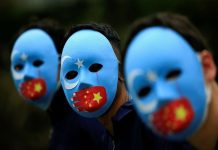A model of the “Pillar of Shame,” a memorial to victims of the Tiananmen Square massacre that was controversially removed from a Hong Kong university in 2021, has gone on display in front of the European Parliament in Brussels.
Depicting a heap of contorted bodies and screaming faces, the statue was unveiled Tuesday as part of an exhibition of “forbidden art” that organizers said had been censored or “deemed subversive” by Hong Kong and mainland China.
The exhibition was hosted by Jens Galschiøt, the Danish artist behind the famous sculpture, and Kira Marie Peter-Hansen, a member of the European Parliament (MEP). A further six MEPs, including representatives from each of the parliament’s five largest political coalitions, were listed as co-hosts.
Galschiøt wrote on his website that installing the artwork outside the European Union’s main legislative building sent a “strong signal to China that its censorship does not apply in Europe.”
Galschiøt called on Western galleries and auction houses operating in Hong Kong’s lucrative art market to address perceived threats to freedom of expression in the territory. “I don’t think they want censorship either, but they (tacitly support it) because, if they don’t, they know it’s not possible to do business,” he said.
Galschiøt created numerous versions of the “Pillar of Shame” in the 1990s and 2000s, though the one installed at Hong Kong University in 1997 — the same year the former British colony was returned to Chinese rule — is the best known among them. Until recently, Hong Kong was the only place on Chinese soil that tolerated memorials to Beijing’s bloody military crackdown on student protesters in 1989, and the sculpture was considered both a symbol and bellwether of free speech in the city.
In 2021, after Beijing imposed a sweeping National Security Law on Hong Kong to ban sedition, secession and subversion, the university removed the statue under the cover of darkness and placed it in storage. Last May it was seized by the city’s police as part of an investigation into “incitement to subversion.”
Symbolic power ‘getting much stronger’
At approximately eight feet seven inches tall (around a third the height of the Hong Kong version), the sculpture on display in the Belgian capital is not a replica but instead one of several smaller models Galschiøt produced in the 1990s. It stands atop a plinth featuring the artwork’s history and a message reading, “The old cannot kill the young forever.”
Tuesday’s grand opening featured a performance of “Glory to Hong Kong,” a protest song that authorities in the Chinese territory are seeking to formally ban. The ceremony was followed by a series of debates featuring politicians and human rights activists.
In a statement, China’s Ministry of Foreign Affairs told CNN that the country’s government has “long drawn a clear conclusion about the political turmoil that occurred in the late 1980s” and that “any attempt to discredit China will only end in failure.”
The 1989 Tiananmen Square massacre remains one of the most sensitive political taboos in mainland China. Discussions of the event are strictly censored and any attempt to commemorate it can lead to imprisonment. Chinese authorities have not released an official death toll, but estimates range from several hundred to thousands.
Last week, Galschiøt published a letter on his website that he and Peter-Hansen received from the Chinese Embassy in Brussels describing the exhibition and debates as “nothing but political maneuvering to grossly interfere in China’s domestic affairs under the pretext of democracy and human rights.”
Elsewhere in the Brussels exhibition, which was organized alongside the Czech Republic-based non-profit NGO Dei, works by self-exiled Chinese artists are displayed alongside a photo of Lady Liberty, the statue of a masked demonstrator that became a symbol of the pro-democracy protests that rocked Hong Kong from 2019.
The unveiling took place on the same day Hong Kong passed a second national security legislation giving police new powers to crack down on dissent. Critics and analysts have warned that the new law, which comes into effect Saturday, aligns the financial hub’s national security laws more closely with those used on the Chinese mainland, leaving the city’s artists and galleries with further uncertainties about what is, or is not, legally permissible.
China and Hong Kong’s leaders say the new laws are needed to “plug loopholes” as part of their drive to “restore stability” following large-scale and occasionally violent pro-democracy, anti-government protests in 2019.
The exhibition also comes as Asia’s largest art fair, Art Basel Hong Kong, opens its doors to gallerists, dealers and collectors from around the world next week.
In the years since Hong Kong’s “Pillar of Shame” was taken down, Galschiøt has unsuccessfully lobbied to have it returned by the city’s authorities. In the meantime, replicas and other versions of the work have been displayed in cities including Oslo, Taipei and Berlin.
The artist said attempts to censor the sculpture had only strengthened its message.
“I think its (power as a symbol) is getting much stronger,” he added. “I wouldn’t say China has helped us … but I think they made a really big mistake. If they’d just given me the sculpture back and said, ‘OK, it’s not allowed,’ then nothing would have happened.”
































